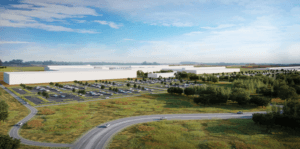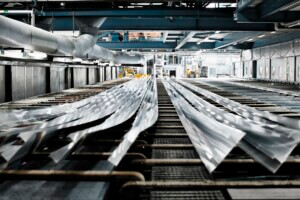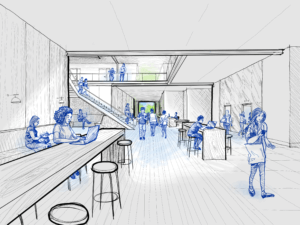For the duration of the coronavirus (COVID-19) crisis, AN will use this column to keep our readers up to date on how the pandemic is affecting architecture and related industries. This weekly article is meant to digest the latest major developments in the crisis and synthesize broader patterns and what they could mean for architecture in the United States. The previous edition of the column can be found here.
This week, the COVID-19 pandemic continued to escalate across the United States, and we’re starting to see signs of how the crisis could affect manufacturing and building supply chains in the long term. While construction slows nationally, architects and manufacturers are turning their hands toward producing personal protective equipment for healthcare workers, responding to current shortages and anticipating the incredible need expected in the coming weeks as the pandemic peaks. These flexible responses could save lives, and the memory of that could spur the country to rethink how it makes things.
Cities, and how residents use them, have already changed quickly. New York and Los Angeles have enacted temporary eviction bans to help people who have lost their jobs because of the economic effects of the pandemic, and state and local governments have repurposed existing structures as healthcare facilities. New York converted the Javits Convention Center into a 1,200-bed emergency hospital, and across the country, parking garages, college dorms, and even parks have been turned into pop-up medical facilities.
Construction freezes across the country have continued and expanded. New York has responded to the crisis by pausing all nonessential construction. Many construction sites in Los Angeles have temporarily closed, although the Los Angeles County Museum of Art is going ahead with the controversial demolition of its current home as it prepares to build its new Peter Zumthor–designed building.
Even aside from mandated site closures, there are signs that work may slow in the months after the pandemic passes. At a virtual town hall last week, representatives from AIA New York discussed how that city’s Department of Design and Construction was cutting its budget ahead of anticipated shortfalls as a result of the pandemic’s effect on the economy.
On a more upbeat note, the speakers at the AIA New York event also discussed a growing movement among architecture firms to 3D print personal protective equipment for healthcare workers. Offices and schools across the country are printing masks and assembling face shields to donate to hospitals. It’s a nice story about how architects can respond to a pressing social need, and it’s also an indication of how much this pandemic is disrupting traditional supply chains. The way the industry heals from these wounds may foster a very different system than the one we are used to.
Many of the recent social distancing orders have affected manufacturers as much as construction companies. As a result of Michigan’s policy, many producers there have had to temporarily close their plants and lay off workers. The state has long been a center for furniture production—brands like Steelcase, Herman Miller, and Haworth are based in or around Grand Rapids, aka Furniture City. Katie Woodruff of Steelcase confirmed that that company has been forced to shutter most Michigan production lines for now, but that the company is fabricating critical equipment for healthcare and government needs, as well as maintaining operations in Alabama and Mexico for essential business and elsewhere in the world as possible.
Not all manufacturers have had to pause. Scott Melnick, senior vice president of the American Institute of Steel Construction, said that “while the rules vary from state-to-state, many fabricators have been classified as essential businesses by state leadership or through the current CISA [Cybersecurity and Infrastructure Security Agency] guidelines, and are still working, albeit with added precautions to minimize worker exposure.” Some of these heavy industry fabrication plants are difficult to take temporarily offline. Glass manufacturers, for example, will stay open regardless of short-term demand, because float glass is deemed critical to national security, partly because it’s used by the defense industry. Float glass plants can take weeks to stop and a year, as well as millions of dollars, to restart—a story on AN will explore that next week.
Some manufacturers, like architecture firms, are radically redirecting their operations to create protective equipment. About two weeks ago, New Jersey-based furniture maker Stylex began producing face masks with their sewing machines and CNC cutting equipment. Sewers are now creating 400 to 500 masks per day for area hospitals. While the masks aren’t equivalent to the much-need N95 masks, Bruce Golden, Stylex co-CEO, said that the masks are being made in accordance with government requirements for donated equipment and CDC guidelines.
Stratasys, a major 3D printing and additive manufacturing company, has also pivoted to producing protective equipment. After receiving requests for face shields, the company scrambled to prototype a model that they could partially print and donate to hospitals and nursing homes. The company made their digital model available online so that other businesses and individuals can sign up to print the face shield parts and send them to Stratasys for assembly (the company asks that partners commit to producing parts for at least 100 shields). Since starting in late March, Stratasys has now produced and donated thousands of shields to hospitals and nursing homes. Others interested in printing and producing models may submit their designs for FDA approval here.
The crisis has exposed the advantages of 3D printing, which allows for extremely quick responses to demand. A representative from Stratasys said that while the company could switch to injection mold manufacturing to produce the shields in greater numbers, that would require two weeks just to make the initial mold. Printing allowed the company to respond in days, and thanks to a diffused national network of printers, production could still ramp up quickly and locally as needed.
These workarounds to the pandemic’s radical disruption of global supply chains could reverberate long after this crisis ends.
“For years, furniture manufacturers, and manufacturers in general, have been compelled to rethink how forces like climate change, geopolitical instability, and supply chain disruptions affect overall organizational resiliency,” Woodruff at Steelcase said. “The COVID-19 global pandemic is very likely to intensify and accelerate efforts to shift operations, and invest in digital technologies to enhance smarter supply chains and create more efficient distribution strategies.”
Customers may focus on domestic goods as memories of this shock live on, or the crisis could spur a boom in diffuse, localized 3D printing networks that could nimbly respond to such disasters. Stratasys reported that a hospital in France recently bought 60 of its printers to produce equipment on site. The lingering anxieties borne by this moment could reshape the country’s approach to manufacturing for decades.
Finally, if you’re looking for something to distract you while you’re cooped up inside, take a look at this roundup of architecture-related movies and shows selected by AN’s editorial staff.
Be well!











